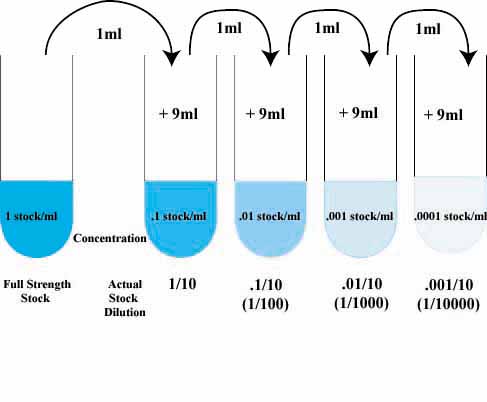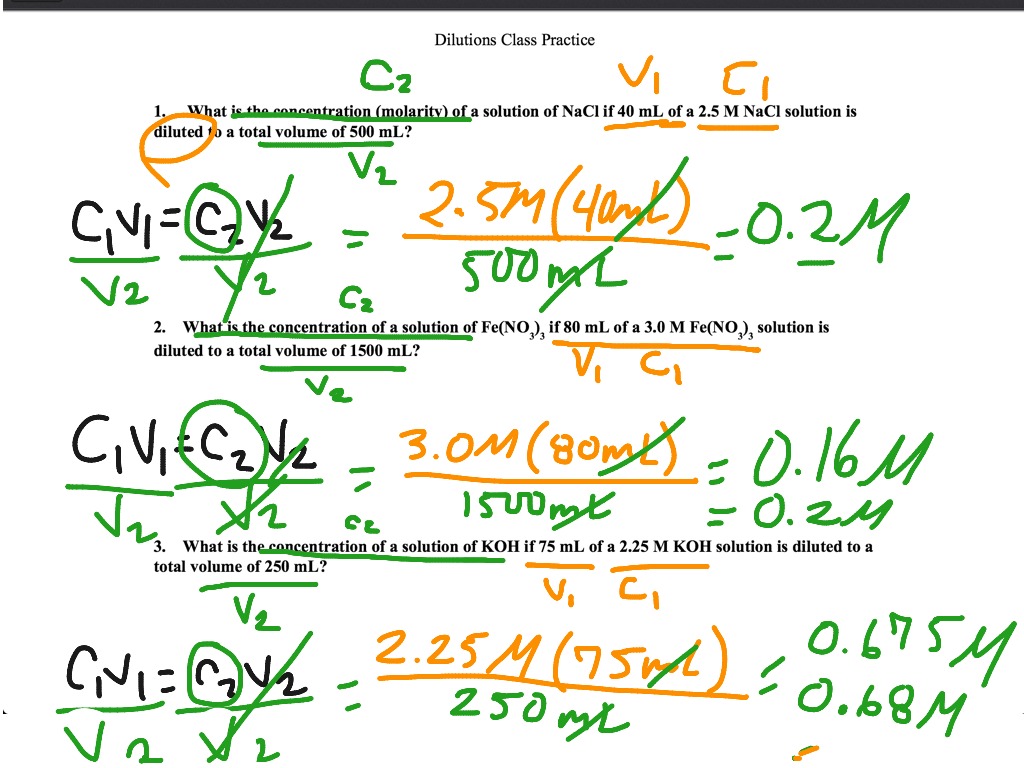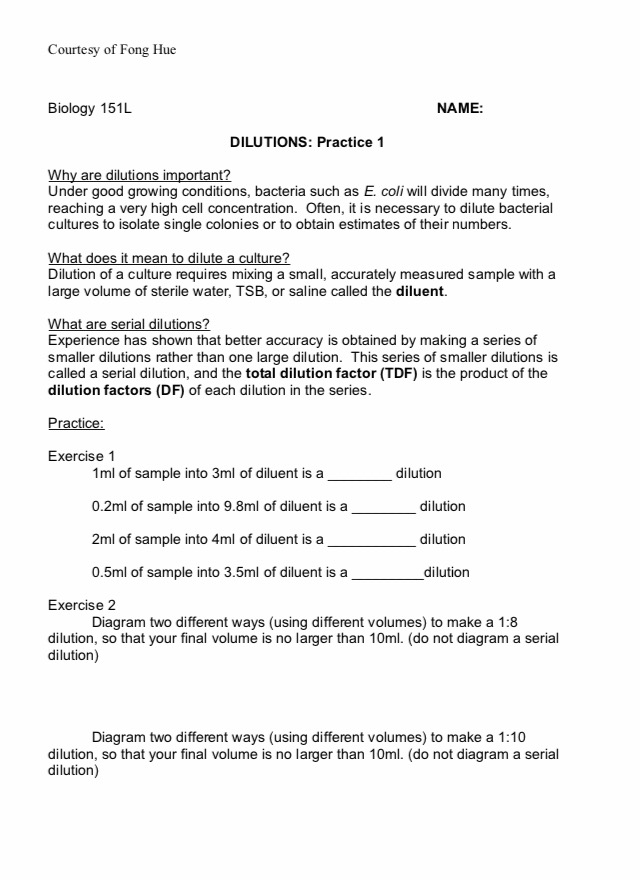Dilution Problems
#1 - 10
#1 - 10
Problem #1: If you dilute 175 mL of a 1.6 M solution of LiCl to 1.0 L, determine the new concentration of the solution.
- Serial Dilution Many procedures performed in modern biology and chemistry laboratories require sets of solutions that cover a range of concentration. s. These include quantifying the number of bacteria in a sample using plate counts and development of standard curves for quantitative colorimetric, radiometric and enzymatic assays.
- Serial Dilution Many procedures performed in modern biology and chemistry laboratories require sets of solutions that cover a range of concentration. s. These include quantifying the number of bacteria in a sample using plate counts and development of standard curves for quantitative colorimetric, radiometric and enzymatic assays.
- More dilution problems. Here is some practice with different dilution schemes. This time the applet will do the counting for you. The first problem should be very easy at this point, but after that you can click on 'Hard Problem' to get trickier dilution schemes.
Solution:
M1VA very quick lesson on how to do the math for serial and simple dilutions.
1 = M2V2(1.6 mol/L) (175 mL) = (x) (1000 mL)
x = 0.28 M
Note that 1000 mL was used rather than 1.0 L. Remember to keep the volume units consistent.
Problem #2: You need to make 10.0 L of 1.2 M KNO3. What molarity would the potassium nitrate solution need to be if you were to use only 2.5 L of it?
Solution:
M1V1 = M2V2(x) (2.5 L) = (1.2 mol/L) (10.0 L)
x = 4.8 M
https://restaurantlucky.netlify.app/ubisoft-game-launcher-mac.html. OverviewUbisoft Game Launcher is a Shareware software in the category Games & Entertainment developed by.It was checked for updates 1,759 times by the users of our client application during the last month.The latest version of Ubisoft Game Launcher is, released on.
Please note how I use the molarity unit, mol/L, in the calculation rather than the molarity symbol, M.
Problem #3: How many milliliters of 5.0 M copper(II) sulfate solution must be added to 160 mL of water to achieve a 0.30 M copper(II) sulfate solution?
Solution:
MSerial Dilutions Practice Problems
1V1 = M2V2(5.00 mol/L) (x) = (0.3 mol/L) (160 + x)
5x = 48 + 0.3x
4.7x = 48
x = 10. mL (to two sig figs)
The solution to this problem assumes that the volumes are additive. That's the '160 + x' that is V2.
Problem #4: What volume of 4.50 M HCl can be made by mixing 5.65 M HCl with 250.0 mL of 3.55 M HCl?
Solution:
Here is the first way to solve this problem:
M1V1 + M2V2 = M3V3(3.55) (0.250) + (5.65) (x) = (4.50) (0.250 + x)
Where x is volume of 5.65 M HCl that is added
(0.250 + x) is total resultant volume
0.8875 + 5.65x = 1.125 + 4.50 x
1.15x = 0.2375
x= 0.2065 L
Total amount of 4.50 M HCl is then (0.250 + 0.2065) = 0.4565 L
Total amount = 456.5 mL
Here is the second way to solve this problem:
 Since the amount of 5.65 M added is not asked for, there is no need to solve for it.
Since the amount of 5.65 M added is not asked for, there is no need to solve for it.M1V1 + M2V2 = M3V3
(3.55) (250) + (5.65) (x - 250) = (4.50) (x)
That way, x is the answer you want, the final volume of the solution, rather than x being the amount of 5.65 M solution that is added.
Problem #5: A 40.0 mL volume of 1.80 M Fe(NO3)3 is mixed with 21.5 mL of 0.808M Fe(NO3)3 solution. Calculate the molar concentration of the final solution.
Solution:
Let's use a slightly different way to write the subscripts:
M1V1 + M2V2 = M3V3
There is no standard way to write the subscripts in problems of this type.
Substituting:
(1.80) (40.0) + (0.808) (21.5) = (M3) (40.0 + 21.5)M3 = 1.45 M
Problem #6: To 2.00 L of 0.445 M HCl, you add 3.88 L of a second HCl solution of an unknown concentration. The resulting solution is 0.974 M. Assuming the volumes are additive, calculate the molarity of the second HCl solution.
Solution #1:
M1V1 + M2V2 = M3V3(0.445) (2.00) + (x) (3.88) = (0.974) (2.00 + 3.88)
0.890 + 3.88x = 5.72712
3.88x = 4.83712
x = 1.25 M (to three sig figs)
Solution #2:
1) Calculate moles HCl in 0.445 M solution:
(0.445 mol/L) (2.00 L) = 0.890 moles
2) Set up expression for moles of HCl in second solution:
(x) (3.88 L) = moles HCl in unknown solution
3) Calculate moles of HCl in final solution:
(0.974 mol/L) (5.88 L) = 5.73 moles
4) Moles of HCl in two mixed solutions = moles of HCl in final solution:
0.890 moles + [(x) (3.88 L)] = 5.73 molesx = 1.25 M (to three sig figs)
Problem #7: To what volume should you dilute 133 mL of an 7.90 M CuCl2 solution so that 51.5 mL of the diluted solution contains 4.49 g CuCl2?
Solution:
1) Find moles:
(4.49g CuCl2) (1 mole CuCl2 / 134.45 grams) = 0.033395 moles CuCl2
2) Find the molarity of the 51.5 mL of the diluted solution that contains 4.49g CuCl2:
(0.033395 moles CuCl2) / (0.0515 liters) = 0.648 M
3) Use the dilution formula:
M1V1 = M2 V2
V2(7.90 M) (133 mL) = (0.648 M) (V2)
V2 = 1620 mL
Serial Dilution Practice Lab
You should dilute the 133 mL of an 7.90 M CuCl2 solution to 1620 mL.
Problem #8: If volumes are additive and 95.0 mL of 0.55 M KBr is mixed with 165.0 mL of a BaBr2 solution to give a new solution in which [Br¯] is 0.65 M, what is the concentration of the BaBr2 used to make the new solution?
Solution:
moles of Br¯ from KBr: (0.55 mol/L) (0.095 L) = 0.05225 molmoles of Br¯ in final solution: (0.65 mol/L) (0.260 L) = 0.169 mol
moles Br¯ provided by the BaBr2 solution: 0.169 - 0.05225 = 0.11675 mol
BaBr2 provides two Br¯ per formula unit so (0.11675 divided by 2) moles of BaBr2 are required for 0.11675 moles of Br¯ in the solution.
molarity of BaBr2 solution: 0.058375 mol / 0.165 L = 0.35 M
Problem #9: 1.00 L of a solution is prepared by dissolving 125.6 g of NaF in it. If I took 180 mL of that solution and diluted it to 500 mL, determine the molarity of the resulting solution.
Solution:
1) Calculate moles of NaF:
125.6 g / 41.9 g/mol = 3.00 mol
2) Calculate moles in 180 mL of resulting solution:
3.00 mol in 1000 mL so 3 x (180/1000) = 0.54 mol in 180 mL
3) Calculate molarity of diluted solution:
0.54 mol / 0.50 L = 1.08 mol/L = 1.08 M
Problem #10: What is the molar concentration of chloride ions in a solution prepared by mixing 100.0 mL of 2.0 M KCl with 50.0 mL of a 1.50 M CaCl2 solution?
(Warning: there's a complication in the solution. It has to do with the CaCl2.)
Solution #1:
1) Get total moles of chloride:
KCl ⇒ (2.00 mol/L) (0.100 L) = 0.200 mol of chloride ionCaCl2 ⇒ (1.50 mol/L) (0.0500 L) (2 ions / 1 formula unit) = 0.150 mol of chloride ion.

The '2 ions / 1 formula unit' is the problem child. The solution is 1.50 M in calcium chloride, but 3.00 M in just chloride ion.
total moles = 0.200 mol + 0.150 mol = 0.350 mol
2) Get chloride molarity:
0.350 mol / 0.150 L = 2.33 M
Solution #2:
Cyrillic font windows 10. To fix it, do the following:Control Panel - Clock, Language, and Region - Region - Administrative - Change systel locale.Then set it to whatever region you live in. It turned out that the problem was caused by me changing my Systel Locale to USA. It didn't help me, I've downloaded the language pack but it still shows some symbols instead of Russian letters.It was the same for me. This causes programs that don't support Unicode (not only Notepad) to be unable to display cyrilic symbols.
Suppose you really wanted to use this equation:
M1V1 + M2V2 = M3V3
Serial Dilution Problems And Answers
Set it up like this:
(2.00 mol/L) (0.100 L) + (3.00 mol/L) (0.0500 L) = (M3) (0.150 L)Note that the CaCl2 molarity is 3.00 because that is the molarity of the solution from the point-of-view of the chloride ion.